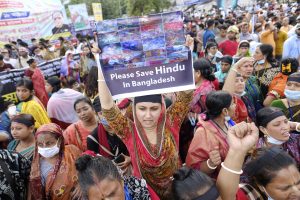Ever since the Taliban stormed to power in Kabul, much of the world’s attention has been on Afghanistan and the return of Islamist tyranny in that country over women and religious minorities. But elsewhere in South Asia too, similar trends are rampant.
Through much of last month, Islamist radicals in Bangladesh plundered and pillaged the Hindu minority, its places of worship, homes and businesses. The violence had long been coming, with the steady rise in Islamic conservatism in the country, but it had apparently been sparked off by an alleged case of blasphemy.
Meanwhile, after years of declining violence, Kashmir was ablaze once more, as a spate of Islamist attacks led to a mass exodus of Hindu and Sikh minorities for the first time since the 1990s. The reign of Islamist terror in Kashmir set itself in contrast against the trend of Hindu majoritarianism that has gripped India in recent years, with Muslims under attack for everything from cow slaughter to inter-religious marriages.
In Sri Lanka, too, religious clashes are reaching a tipping point. Ahead of their run to political power last year, the powerful Rajapaksa clan had played up Sinhala-Buddhist nationalism to contrast themselves against the fragile multi-party coalition that had preceded them.
Not coincidentally, those divisions have gotten worse since the beginning of their term: In recent days, multiple organizations, including Amnesty International and the U.S. Commission on International Religious Freedom (USCIRF), have flagged concerns over the ban on burqas and Muslim religious schools, as well as the replacement of Hindu temples with Buddhist temples in the restive northeast.
Even elsewhere, similar historical patterns of majoritarianism and persecution continue. In Pakistan, the rise of the Taliban has been widely cheered: A Gallup poll this September found that 55 percent of Pakistanis were “happy” with that development. In Myanmar, this year’s military coup has put all religious minorities in trouble. Toward the end of October, a military offensive killed scores of civilians and destroyed religious buildings in the heavily Christian-dominated Chin region. Attacks against the Muslim Rohingyas of course continue.
The problem for South Asia is that these are not temporary or extraordinary scuffles; they are historic clashes that are progressively getting worse by feeding each other. Across India, Pakistan and Bangladesh, majoritarian populism on either side of the Hindu-Muslim divide points fingers at the other community to justify its own aggression.
Hindu nationalist politicians in India defended the discriminatory Citizenship Amendment Act (CAA) by citing the violence against Hindus in Bangladesh, even though the CAA does nothing for any victim who arrived in India after 2014. Meanwhile, Bangladeshi Prime Minister Sheikh Hasina argued that India’s treatment of Muslims was stoking anger toward Hindus in her own country.
Yet, things only seem set to get worse.
Vaccination has picked up across South Asia and national economies are recovering. In its latest report on the region, the World Bank has projected that South Asia’s GDP will grow by over 7 percent in 2021 and 2022. But that figure is based on the very low base of 2020, when the pandemic devastated economies everywhere.
The World Bank’s forecast says that South Asia’s average annual growth over 2020-2023 will be 3.4 percent, which is 3 percentage points lower than in the four years preceding the pandemic. In all, the pandemic is estimated to have caused 48 to 59 million people to become or remain poor this year.
In the aftermath of the pandemic, economic uncertainty and rising fuel costs have thrown up challenges for incumbents in power everywhere, and majoritarianism is a tempting way to divert public attention.
Sure enough, in the run-up to politically significant state elections in India, the ruling Bharatiya Janata Party (BJP) has begun to ramp up communal rhetoric. In the state of Uttar Pradesh, Chief Minister Yogi Adityanath has invoked the Taliban in his political speeches against opposition parties multiple times in a variety of contexts. In Gujarat, local administrations in different cities are passing diktats against meat-eating.
Meanwhile, in an effort to consolidate its unpopular coup, the military junta in Myanmar too has tried to exploit religious differences. According to Thet Swe Win, the founder of Synergy, an organization that promotes interfaith efforts in Myanmar, around 80 percent of the country’s Buddhists oppose the military coup. But many Buddhist monks are also opposed to the acceptance of minorities such as the Rohingya Muslims, and the junta is hoping to win over them through both intimidation as well as majoritarianism.
Likewise, in Afghanistan, as a searing economic crisis tests the limits of the Taliban’s governance capabilities, and the resurgence of the Islamic State-Khorasan (IS-K) challenges its appeal to hardline Islamists, the Taliban could well revert to its traditional brutality towards minorities in an effort to consolidate power and motivate its own cadre.
For many years, South Asia has been a region of promising demographics and economic potential. But in the face of identity clashes across the subcontinent, South Asia’s long-term growth prospects are now under threat. The region is in desperate need of unifying and inclusive political leadership. Yet, that is nowhere to be seen.

































